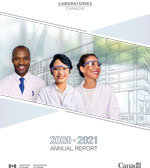PDF version
Assistant Deputy Ministers’ message
Laboratories Canada is a long-term strategy to strengthen federal science. The vision is to build modern, accessible, and sustainable laboratories while addressing critical enablers such as scientific equipment, IM/IT systems and barriers that inhibit collaboration.
Since the strategy was established in 2018, Public Services and Procurement Canada, its partners and stakeholders have been working to advance Phase 1, which will lead to a first set of scientific facilities and strategies that will bring together the brightest minds on crosscutting research and regulatory work that impacts the lives of Canadians.
In the fiscal year 2020–2021, Phase 1 of the strategy has moved by and large from planning into implementation despite challenges caused by COVID-19. Among this year’s key developments:
- The 5 science hubs and 12 laboratory projects across the National Capital Region and other regions have laid the foundational work for scientific collaboration and the delivery of world-class laboratory facilities;
- Functional programming has advanced for all five science hubs to define detailed requirements for the projects;
- A series of requests for proposals were launched to initiate contracts for architecture and engineering services; and,
- Enterprise approaches have been drafted for portfolio planning, facility custodianship, scientific equipment sharing and procurement, and IM/IT enablement.
Governance also evolved in 2020–2021 to streamline processes, based on sound, evidence-based decision-making.
In addition, the Laboratories Canada office provided important support in the government’s response to the pandemic. The team demonstrated great adaptability and was able to leverage its strong relationships with partners and the greater federal science community to provide direct support for Canadians.
- We are proud of the support provided to the Public Health Agency of Canada and its partners via our national coordination role across the federal science community to assist the agency’s National Microbiology Laboratory.
- The same team responsible for project delivery for Laboratories Canada led the successful delivery of the National Research Council’s Biologics Manufacturing Centre project ahead of schedule in the early and uncertain days of the pandemic (Royalmount in Montréal).
- Furthermore, we supported the Treasury Board Secretariat and the Office of the Chief Human Resources Officer during difficult times by monitoring COVID-19 financial impacts and quickly putting contracts in place in response to the pandemic, ensuring the continuity of corporate services.
Strong investment in science supports Canadians’ present and future health, safety, and prosperity.
With gratitude to our employees, science hub colleagues and partners, whom with dedication and effort, are making this profoundly transformative strategy possible, we invite you to read this report.
The Laboratories Canada long term vision and plan
In 2018, a Long Term Vision and Plan was outlined for the Laboratories Canada strategy. The plan sets the strategic direction for Laboratories Canada, and positions it as an ambitious, whole-of-government, long-term transformative strategy to deliver a world-class national ecosystem of modern, multipurpose and sustainable federal science and technology laboratories.
The Laboratories Canada strategy is led by a program office housed within the Science and Parliamentary Infrastructure Branch of Public Services and Procurement Canada (PSPC). The Science and Parliamentary Infrastructure Branch provides functional leadership and operational delivery of the strategy, and engages partnering departments and agencies through horizontal governance.
The Long Term Vision and Plan aims to create a forward-looking, integrated approach to building new federal laboratories and enabling federal scientists who will deliver results for Canadians, spark multidisciplinary research and attract the next generation of scientists.
Pillars and principles
Four pillars are central to the Laboratories Canada strategy and Long Term Vision and Plan to ensure an effective framework that enables world-class science within the Government of Canada.
Facilities: Laboratories Canada investments will replace aging critical science infrastructure to build leading-edge collaborative, accessible, and sustainable facilities.
IM/IT: Laboratories Canada, in close collaboration with Shared Services Canada, is developing a comprehensive strategy to address the need for modern, agile IM/IT infrastructure to support scientific collaboration while enhancing the security of core federal IM/IT systems.
Equipment: Laboratories Canada is developing a whole-of-government approach to sharing, managing, and procuring scientific equipment to provide scientists with the tools they need to advance multidisciplinary research and regulatory work.
Barrier Mitigation: Laboratories Canada is working with its partners to understand and address barriers that inhibit collaboration between federal scientists and their external partners. For instance, Laboratories Canada has identified a list of scientific equipment available to federal scientists so they can readily access the equipment required.
4 Pillars
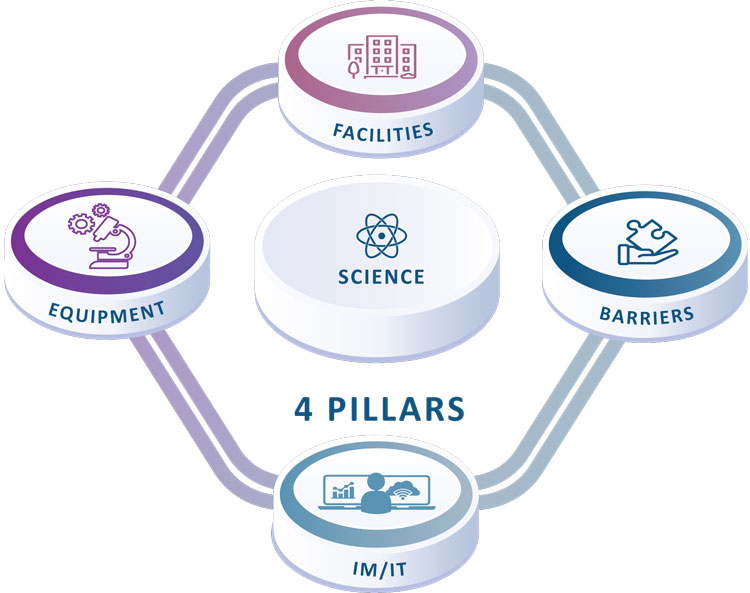
-
4 Pillars - Text version
Four short pillars, connected by lines, are surrounding a pill-shaped object with the word, “science.” Each pillar has words and an icon that represents that pillar. The word, “facilities” and an icon of a building represent one pillar. The word, “equipment” and an icon with a microscope and gears represents another. The words, “IM/IT” and an icon of a person at a computer terminal represents the third pillar. Lastly, the word, “barrier” and an icon of a hand, holding a jigsaw puzzle piece represents the fourth pillar.
Guiding principles
Science excellence
Renewed federal laboratories will support high-impact science that informs decision-making and addresses the challenges of today and tomorrow.
Collaboration
Designed and equipped as collaborative science hubs, renewed laboratories will bring scientists together and foster a culture of openness and engagement with new partners and stakeholders.
Inclusive and diverse talent pool
Modern and collaborative spaces will attract and retain high-calibre, diverse scientists, helping build Canada’s capacity for scientific innovation.
Agility and responsiveness
Flexible, adaptable space will ensure that scientists can respond quickly to shifting priorities, emerging scientific discoveries, and stay at the cutting edge of their fields.
Environmental responsibility
Environmentally sustainable facilities will be climate resilient and carbon neutral, supporting government commitments on climate change and green operations.
Public stewardship
A prudently managed science and technology asset portfolio will result in fit-for-purpose facilities that maximize space, reduce redundancy, and optimize investments.
Laboratories Canada office
The Laboratories Canada Office is leading a horizontal effort across 14 partnering departments and agencies, with a strong focus on science, to advance work under the strategy’s pillars. Its role is to bring together federal science-based departments and agencies and external stakeholders, drawing from the experience and expertise of federal scientists to lay the groundwork to build world-class facilities, facilitate enterprise-wide best practices, exercise financial stewardship, and ensure diligent governance. The Laboratories Canada Office will continue to evolve its structure and vision as the strategy is implemented, applying lessons learned along the way.
Science hubs
The first phase of Laboratories Canada advances key government science outcomes while addressing existing laboratory facilities in poor and critical condition and at risk of failure. The 14 science-based departments and agencies involved in Phase 1 were brought together because of their common science goals and are collaborating to further strengthen their research through enhanced interdisciplinary work and shared facilities.
Regulatory and security science (RSS):
Protect human and animal health from emerging threats; secure our food supply and borders.
Cultural heritage science (CHS):
Preserve Canada’s significant heritage artifacts for the future while advancing nationally significant reconciliation.
TerraCanada:
Support clean energy, manufacturing, and low-carbon economy; research on critical minerals.
Transportation safety and technology science (TSTS):
Assess and reduce transportation safety risks for Canadians; create new technologies to improve safety certification; responsive and accurate investigations; enhance transportation safety.
Atlantic science enterprise centre (ASEC):
Protect coastal ecosystems in a changing climate; sustainably grow our blue economy.
Benefits to Canadians
Beyond strengthening science decision-making and outcomes for Canada’s science community, Laboratories Canada offers a broad range of benefits for people across Canada. Access to equipment, spaces to gather for discussions and the digital structure to support their work result in improved outcomes for Canadians in varied industries and regions.
Strong investment in science supports Canadians’ present and future health, safety, and prosperity. The rapid response to the threat of COVID-19—initially identifying it, understanding it and later, adapting protocols as more data became available—underlines the essential role science plays, providing decision-makers with accurate information in a timely manner that allows for action on policies that is adaptable and relevant.
Other benefits include:
- Jobs and Skills Development: An interconnected science ecosystem drives innovation, creates new jobs and fosters skills that grow research and development capacity in the science community. Phase 1 investments will create an estimated 20,000 direct jobs in architecture, engineering, manufacturing, trades and the construction sectors across Canada. An Indigenous Participation Program will support the involvement of Indigenous partners by requiring a minimum of 5% of the jobs on Phase 1 projects to be held by Indigenous workers and professionals.
- Science Collaboration: Laboratories Canada will continue collaborating with other federal science partners to enable scientific advancements. With scientists engaged in the development of the Repeatable Laboratory Design Framework, and with at least two federal science partners with compatible science objectives housed in each facility, the opportunities for cross-departmental science collaboration are dramatically increased. It also provides the opportunity for increased sharing with other scientists from academia, industry as well as international partners.
- Tangible Investments: Construction is expected to begin on some of the facilities as early as 2021–2022, and several facilities are expected to be in full operation within 3–4 years, stimulating the economy through investments in traditional sectors in Canada, including forestry, mining and aquatic resources.
- Efficiency: Laboratories Canada is being delivered in close alignment with the Government’s Horizontal Fixed Asset Review, which will improve the management of assets across government and better align the government’s real property footprint with its program requirements. Efficiencies will be realized through the shared use of facilities, maximizing the space and resources within each facility. The repeatable nature of the laboratory designs will also simplify the maintenance and lifecycle management of the facilities.
- Accessibility: Aligned with the Accessible Canada Act, Laboratories Canada is committed to accessibility while advancing federal science and technology. New collaborative laboratories will lead by example to create an accessible and inclusive workplace.
- Sustainability: Laboratories Canada is committed to demonstrating leadership in low-carbon, climate-resilient, and green operations, with new facilities designed to meet federal standards for environmental sustainability and have a net-zero footprint. Projects will also adopt sustainable construction practices.
- Broad Procurement Benefits: Construction management firms are being awarded large contracts. However, 90% of their value is being subcontracted to small and medium enterprises from across the country. The launch of the National Master Supply Arrangement for Scientific Equipment, Parts, and Services simplifies procurement, increasing efficiencies and savings for taxpayers.
- Lower Risk Overall: Laboratories Canada is a once-in-a-generation opportunity to lower risk on federal science infrastructure and accomplish a broad array of objectives rooted in strengthening and modernizing Canada’s approach to federal science. It positions Canada for international leadership in areas critical for the public good and economic advancement.
Year in review
The 2020–2021 fiscal year was marked by the COVID-19 global pandemic, and the Government of Canada’s response to address the threat while protecting the health and safety of Canadians. A global race to understand the virus, and to develop vaccines and treatments, evolved through the year with both the Laboratories Canada Office and its partners.
Federal departments and agencies transitioned suddenly to virtual work, continuing to deliver core federal programs and services while refocusing priorities and pivoting resources to contribute to the government’s collective response to the pandemic.
Key partners in the Regulatory and Security Science hub—Health Canada, the Public Health Agency of Canada, the Canadian Food Inspection Agency, and the Canada Border Services Agency—had significant roles in the pandemic response. The Laboratories Canada Office worked with the hubs to provide flexibility while continuing to advance the hub project in consideration of the partners’ operational pressures.
Laboratories Canada projects were entering a critical stage known as functional programming when the shift to virtual work occurred. Extended project teams of future building occupants, architects, engineers, and project managers successfully advanced this complex, lengthy technical process virtually. Work on key horizontal elements of the strategy also continued, such as site selection approvals and an expedited scientific equipment procurement process.
Projects: From functional programming, to design, to construction
2020–2021 saw Laboratories Canada projects advance in functional programming, design and construction thanks to strong partnerships, project delivery and partners.
Site selection
Confirming locations for Laboratories Canada’s new science facilities was an important step in the planning process. Developing modern, adaptable and functional laboratories is only effective if the laboratories are accessible to employees and partners, fit within the community and most importantly, support the science.
Following the methodical, evidence-based process to identify and assess site options with science needs as the key driver, governance committees engaged each science hub to confirm final site options and recommendations.
In July 2020, the Chair of the Deputy Minister Science Committee and Associate Deputy Minister of Public Services and Procurement Canada presented the final site options and recommendations to the committee for review and consideration. The Committee acknowledged the successful, evidence-based process with robust engagement of science hubs, and reached a consensus on the recommended sites.
5 science hubs
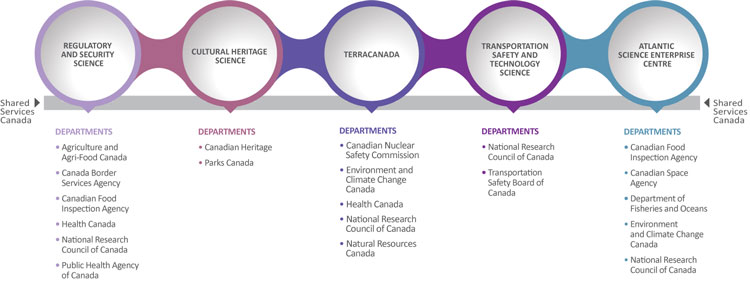
-
5 science hubs - Text version
Five connected circles run laterally across the top of the page. Each circle represents a science hub, with the hub name written within the circle. Below and connected to the bottom of the circles is a banner representing Shared Services Canada, demonstrates that the agency is connected to and supports each of the science hubs. Also below each circle is a list of the departments and agencies that are collaborating within that hub.
The first circle on the left is the Regulatory and Security Science hub. The associated departments are: Agriculture and Agri-Food Canada, Canada Border Services Agency, Canadian Food Inspection Agency, Health Canada, National Research Council of Canada and the Public Health Agency of Canada.
The next circle to the right, is the Cultural Heritage Science Hub. The departments in this hub are: Canadian Heritage and Parks Canada.
In the next circle is TerraCanada. The associated departments are: Canadian Nuclear Safety Commission, Environment and Climate Change Canada, Health Canada, National Research Council of Canada and Natural Resources Canada.
The fourth circle, shifting right represents the Transportation Safety and Technology Science hub. The two associated departments are: National Research Council of Canada and the Transportation Safety Board of Canada.
The final circle on the far right is Atlantic Science Enterprise Centre. The representative departments are: Canadian Food Inspection Agency, Canadian Space Agency, Department of Fisheries and Oceans, Environment and Climate Change Canada and, the National Research Council of Canada.
Project lifecycle
Each Laboratories Canada project follows three broad stages in the project lifecycle. The first stage addresses consolidating the science requirements of each science hub and setting up a governance process. Functional programming is the central activity in the second stage and defines the detailed requirements for design and construction. The third stage targets complete construction and delivery of the facility, ready for use. Major projects are now in stage 2 of the project lifecycle.
A major milestone was reached in the Laboratories Canada project process in 2020–2021 when all science hubs advanced through functional programming.
Hub Inception
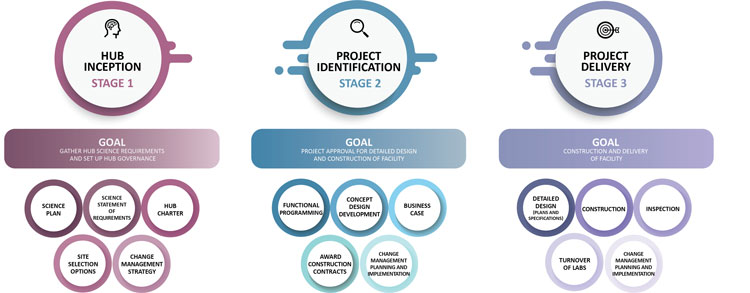
-
Hub Inception - Text version
Three separate circles are at the top of the diagram, each representing a stage in the project lifecycle. Stage one is hub conception. Stage two is project identification. Stage three is project delivery.
Below each circle is a banner with the goal for each stage. Stage one is to gather hub science requirements and set up hub governance. Stage two's goal is project approval for detailed design and construction of the facility. Stage three is construction and delivery of the facility.
Beneath each stage goal are small circles with the elements required in each stage. Stage one elements are: science plan, science statement of requirements, hub charter, site selection options and change management strategies. Stage two elements are: functional programming, concept design development, business case, award construction contracts and, change management planning and implementation. Stage three elements are: detailed design, including plans and specifications, construction inspection, turnover of labs and finally, change management planning and implementation.
Functional programming
Functional programming is a vital activity in the progression of project development. It follows a methodical, step-by-step process with close engagement by the partners to define a project’s detailed requirements that will enable the baseline scope, costs, and timelines for projects.
For Laboratories Canada, the primary objective of implementing the functional program is to provide science hubs, personnel and teams the opportunity to inform the design process, ensuring the project’s outcomes meet their requirements. Functional programming can act as a mechanism for setting and managing a project’s scope, while working to support creative and innovative planning and design solutions.
Did you know?
The functional program process serves many purposes:
- It documents programs, services, and functions to be housed within the facility; operational procedures and methods; functional relationships; projected staffing; room typologies, room-by-room space and equipment requirements, and the overall size for the facility; as well as surrounding site requirements.
- It is a planning tool that captures the project’s detailed requirements necessary for it to function as intended.
- It is a communication tool to enable resource planning and project approvals.
- It is the foundation document for building design, providing information to the architecture and engineering team to translate functional needs into reality.
Functional Programming Process
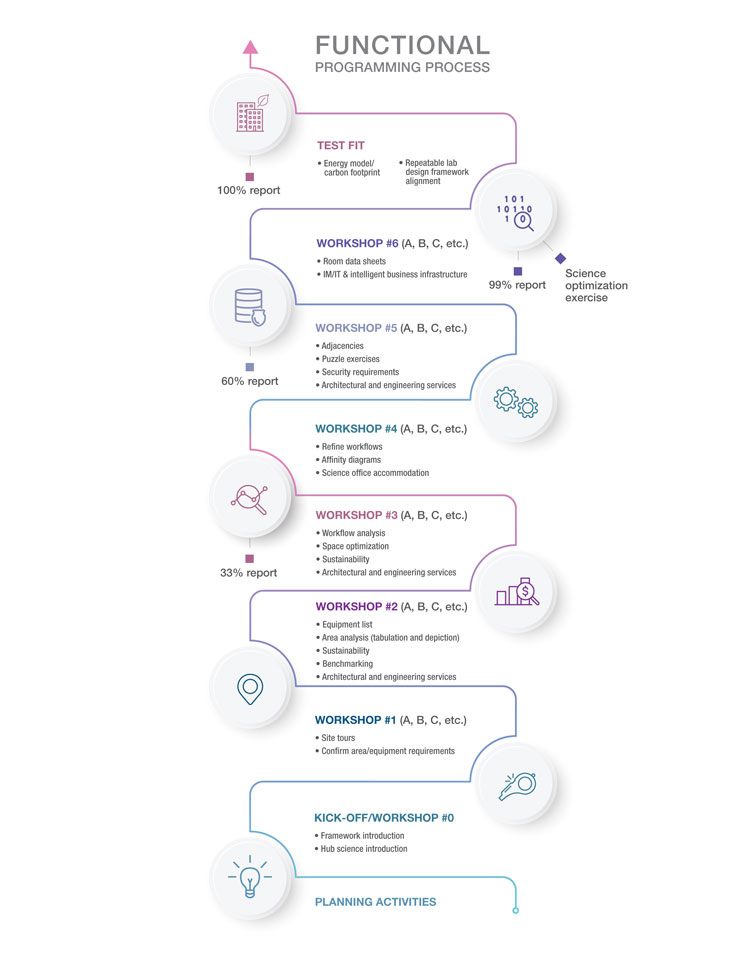
-
Functional Programming Process - Text version
Flow chart, starting at the bottom of the image and zig zagging up the image, involving nine steps in the functional programming process.
The first step is planning activities to set up the process. Step two is the kick-off workshop number zero. There are two points in this step. One is an introduction to the framework process. The second is an introduction to the science hubs.
The next step is workshop number one. The points in this step are tours of the proposed sites and confirming area and equipment requirements for the hub.
Workshop number two is the next step. There are five points in this step; development of a list of needed equipment, an area analysis, exploring sustainability, developing benchmarks for the project and, specifying architectural and engineering services.
Workshop number three represents 33 percent of the work needed to produce the functional program. The points in this step are: an analysis of work flow, exploring space optimization, assessing sustainability and discussion with architectural and engineering services.
Workshop number four starts to tie together the information gleaned from previous workshops. This includes: refining workflows, creating affinity diagrams that organizes the ideas from brainstorming sessions into their natural relationships and lastly, developing science office accommodation.
Workshop number five represents 66 percent of the process completed. In this step participants explore adjacencies, puzzle exercises, security requirements and collaborations with architectural and engineering services.
Workshop number six represents 99 percent of the work completed to produce the functional program. The points in this workshop include: development of room data sheets and studying IM/IT and intellectual business infrastructure. This step finishes with a science optimization exercise.
The final step is the test fit. This step includes analysis of the energy model and carbon footprint. It also includes alignment of the repeatable lab design framework. This represents one hundred percent of work needed to produce the framework.
Throughout 2020–2021, science hubs were fully engaged, understanding the importance of this process in laying the foundation for successful projects. Shared leadership from the Laboratories Canada Office and active participation from scientists and real property representatives across departments and agencies underpinned the functional programming development. It put science at the forefront and allowed scientists to identity their needs, requirements and what the facilities need to be and do to enable them to perform leading-edge, collaborative science.
Science voices, perspectives, and experiences informed the process at every step, cementing an understanding of the requirements for the new science facilities and providing the core information that architects and engineers need to design optimal platforms for their science programs.
For each science hub, the functional program process involved a series of complex, multi-day workshops with hub scientists and real property representatives, Laboratories Canada Office team members, and the designers. Some workshops focused on quantifying the different types of laboratories and support space, identifying how science workflows will occur, and bringing attention to a deeper understanding of required or prohibited adjacencies for the different spaces. For example, the shielding of radiation-producing equipment, or the need for vibration isolation so vibration-inducing activities do not affect sensitive equipment nearby. The enabling pieces, like equipment and IM/IT, were woven throughout the process, such as determining equipment integration and working through security requirements to protect and secure spaces and data.
Phase 1 Major Projects

-
Phase 1 Major Projects - Text version
Functional programming for Phase One projects utilized two hundred plus days of workshops, involving two hundred fifty plus scientists, researched and hub staff.
Functional Programming
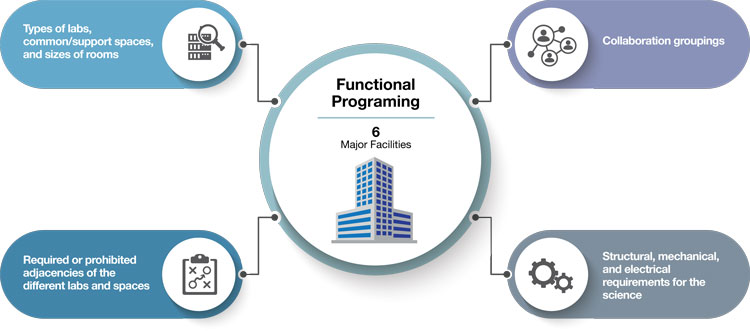
-
Functional Programming - Text version
The centre of the image holds a circle with the words, “functional programming,” representing the six major facilities being developed in Phase One. At each corner of the image are bullets that explain the various areas of focus when delivering the functional programming.
The first area of focus explores the types of labs, common and support spaces, and room sizes. The second area of focus is collaboration groupings. The third area of focus emphasizes required or prohibited adjacencies of different labs and spaces. The last area of focus addresses the structural, mechanical and electrical requirements for the science.
Scientists lead all of the key inputs:
- Plans for science collaboration
- Full-time employees and users for the new facilities
- Synergies to be strengthened via the new facilities such as shared work and partnerships
- Science operational processes and workflows
- Functional and technical requirements on equipment, IM/IT, security, etc. to enable research and regulatory activities
Not losing sight of Laboratories Canada’s foundational objective of transforming and modernizing the laboratories, the completion of functional programming with each hub confirmed the full scale of each project.
Laboratories Canada leveraged the expertise of FRAMEWORK, a joint venture between Stantec, Merrick, and DIALOG to develop standards for federal science laboratories. They are involved in a number of key Laboratories Canada aspects, including the development of a Repeatable Laboratory Design Framework, as well as functional programming and conceptual designs for new facilities. In terms of functional programming, FRAMEWORK played a challenge function role in order to ensure sound requirements that reflect client and program needs. The firm’s experts have extensive architectural and engineering expertise and experience in creating science facilities.
In-flight projects
TerraCanada Hamilton and Mississauga
The Laboratories Canada TerraCanada Science and Innovation hub is a joint National Research Council of Canada and Natural Resources Canada research program. The program’s laboratories will be housed at the National Research Council of Canada’s advanced materials research facility in Mississauga and at Natural Resources Canada’s of Canada’s CanmetMATERIALS facility in Hamilton. These two facilities will bring together collaborative research dedicated to accelerating the discovery and development of new materials to power Canada’s low-carbon economy using material acceleration platforms.
Material acceleration platforms are self-driving laboratories that use artificial intelligence to predict, using both theoretical considerations and real experimental data, which materials or molecules have the desired characteristics required by scientists. The material is then created, processed, and tested on the material acceleration platforms using robotics and automation. This closed-loop cycle of prediction and automated synthesis and characterization is performed in real time to accelerate the development time and reduce the cost of a new material.
TerraCanada Hamilton is the fastest advancing project, having reached the design and construction stages.
The new laboratory space is within an existing facility built in 2010 to Leadership in Energy and Environmental Design platinum standard that houses 100 staff and over 30 collaborative researchers from academia and industry.
The project involves the fit-up of a 92 m2 laboratory space in the CanmetMATERIALS facility:
- Modifications to mechanical and electrical infrastructure;
- Installation of fume hoods, ceiling service carriers, and vacuum chamber (glove box);
- Improved lighting and facility access; and
- New casework including tables, mobile benches, mobile cabinets, sinks, and wall cabinets.
The year 2020 saw foundational work completed for the Hamilton facility: from functional programming, to early design works package, to schematic design, to design and construction contracting. Construction work started in January 2021 within Natural Resources Canada’s existing CanmetMATERIALS building.
The TerraCanada Mississauga project proceeded through the design and construction contract award stages. These involved continuing the construction of the new facility, adding approximately 4,000 m2 of space.
The building will be outfitted on the unfinished 2nd floor, and the 3rd and 4th floors will be constructed. Additional work includes:
- Installation of a new clean room that is designed to maintain a very low concentration of airborne particulates and that is well isolated, well controlled from contamination, and actively cleansed;
- Completion of freight and passenger elevators;
- Installation of science equipment; and
- Modern information management and information technology (IM/IT) systems.
TerraCanada Mississauga completed a feasibility study, functional programming and schematic design in summer 2020. Construction started in fall 2020 while design development was being finalized, allowing for an architecture and engineering contract to be awarded. Contract with specialized trades, including structural steel, rough carpentry and precast concrete, were then secured in early January 2021, and work commenced.
The Atlantic Science Enterprise Centre science hub will become a transformational player in understanding, protecting and sustaining Atlantic freshwater and coastal ecosystems of the Gulf of St. Lawrence and the Atlantic Ocean regions. In order to achieve this vision, Public Services and Procurement Canada is leading the hub infrastructure project by redeveloping the Gulf Fisheries Centre in Moncton, New Brunswick, over the next decade into a modernized, multi-department science centre.
During 2020–2021 the project progressed in many areas, including the completion of the Science Statement of Requirements document which includes the decision that PSPC will remain the custodian for the site, as well as the project feasibility analysis and functional programming reports, which were completed in December 2020. Schematic design was also started in late 2020, while planning and engagement with the Indigenous economic development organizations, most notably the Joint Economic Development Initiative and Mi’gmawe’l Tplu’taqnn Incorporated, began in early 2021. Requests for proposals for the construction management services and architectural and engineering services were posted on Buyandsell.gc.ca in April 2021 and included a mandatory 5% Indigenous Participation Plan. Both contracts, which will support the lifespan of the project, will be awarded in 2021–2022.
The Atlantic Science Enterprise Centre hub project demonstrates the significance of each stage of the project’s lifecycle in ensuring sound oversight, responsible financial management, and forward-thinking science.
When conversations as part of the hub feasibility study took place in 2020, it was recognized that an Aqualab could become a significant feature within the new facility. An Aqualab allows researchers to conduct research on aquatic ecosystem trends, climate change impacts, and cumulative stresses in order to better inform future regulatory requirements.
During functional programming discussions, the requirement for an Aqualab was incorporated into the Atlantic Science Enterprise Centre hub project, and the St. Andrews Biological Station of the Department of Fisheries and Oceans was identified as a key partner.
As a result of the functional programming discussions, the decision was made to locate the Aqualab at the St. Andrews Biological Station. The Atlantic Science Enterprise Centre hub will be able to offer science capability sooner and at a lower cost, as well as ease some resource pressures on the hub infrastructure project. The St. Andrews facility will be improved thanks to the Atlantic Science Enterprise Centre, and its expertise in wet laboratories and aquatic climate change will benefit from this additional collaboration.
Supporting the Government of Canada COVID-19 Response Efforts
In August 2020, the Prime Minister and the Minister of Innovation, Science and Economic Development announced $126 million for the National Research Council of Canada to begin work on a Biologics Manufacturing Centre. Located on the National Research Council’s Royalmount Avenue site in Montréal, the centre is a new, end-to-end biomanufacturing facility that will produce critical vaccines and other biologics.
The construction of the Biologics Manufacturing Centre was a collaboration between Public Services and Procurement Canada and the National Research Council of Canada as part of the response to the COVID-19 pandemic, bolstering the Government of Canada’s capacity and future preparedness to manufacture and test vaccines. As the project sponsor, National Research Council of Canada was mandated to build the facility, while PSPC’s Science and Parliamentary Infrastructure Branch, which leads the Laboratories Canada program, provided project delivery expertise to oversee the management of the construction and engineering services contracts and to deliver the project.
The pandemic, and resulting waves of lockdowns across the country, placed a tremendous strain on the Government of Canada to deliver programs and services while responding in real time as the pandemic evolved to protect the lives of Canadians. Laboratories Canada rose to the challenge, supporting departments and agencies with key initiatives as part of the government’s pandemic response.
PSPC advanced the Laboratories Canada program and leveraged its strong relationships across the federal science community to provide direct support in critical response efforts.
Using a competitive contracting process, an architecture and engineering firm with extensive experience in designing pharmaceutical facilities and a major construction company were brought on board. Based on the needs expressed by National Research Council of Canada scientists, engineers and architects were able to design the operation, functionality and built environment of the plant with the construction firm on site to realize the plan. Through collaboration, experts identified roadblocks, evaluated innovative solutions and took rapid decisions to ensure the facility was delivered within a record 10-month period and allocated budgets. The use of 3D modelling technology and state-of-the-art construction solutions, including prefabricated panels, also contributed to the incredible success of this project. These practices will serve as a model for future Laboratories Canada projects.
The project was undertaken from start to finish during the pandemic, with the team overcoming challenges to complete design and construction ahead of schedule, and on budget, in July 2021.
While PSPC actively worked with the Public Health Agency of Canada and suppliers to procure and deliver medical equipment and supplies across Canada, the Laboratories Canada Office played an instrumental role in coordinating across the federal science community to identify and redirect, where appropriate, federal resources that were in urgent need, such as laboratory equipment and testing supplies.
In addition, the Laboratories Canada Office worked diligently to assist the Public Health Agency of Canada with information technology solutions that facilitated the rapid and secure exchange of large amounts of genomic data with provincial, territorial and academic COVID-19 testing partners. The Laboratories Canada Office partnered with the Public Health Agency of Canada’s National Microbiology Laboratory, private sector partners, PSPC’s Acquisitions Branch and Shared Services Canada to implement a secure network and cloud solution that bolstered the Public Health Agency of Canada’s national COVID-19 pandemic response capabilities.
Change management
Part of the Laboratories Canada mission is to change the way science is conducted within the Government of Canada through greater collaboration and new facilities. Change management is critical to ensuring the success of this mission. Change management can be best described as the application of a structured process and set of tools to help lead people in order to achieve a desired outcome. Supporting employees through change dramatically improves their adoption, resulting in improved outcomes.
Laboratories Canada has integrated change management components because it values public servants’ contributions and understands the impact of change on its workforce. Effective change management strategies at each stage prepares the people involved for the transition and can result in stronger support for the new collaborative environment.
Integrating change management to match the progress of project management is delicate and may be impacted by multiple factors, such as the complexity of the projects, capacity issues, awareness of the projects, readiness of the science hubs to support staff in the changes and competing priorities within the science hubs, etc.
To support the long-term transformative strategy for federal science, Laboratories Canada formed a change management team geared to support the science hubs through the lifespan of the program.
A Change Management Playbook was created to support the science hubs in developing change management plans and addressing the changes required for conducting science in the federal landscape brought by the Laboratories Canada Phase 1 project. It includes guidance, tools and templates to support the analysis needed to inform the change management strategy required to implement the changes.
To create a common understanding of the change management concept and its principles, the Laboratories Canada Office created a change management training roadmap. The first training session was delivered to 153 individuals, from Laboratories Canada senior management to science hub leaders and partners.
One of the key objectives is to bring about a change in how science is done and to support scientists through this change. The Laboratories Canada Office will continue developing change management tools for the science hubs to support their science partners and for employees to understand, welcome and adapt to the new way of doing federal science.
Union engagement
The Laboratories Canada Office understood from the onset the critical role unions play to ensure the Government of Canada has a strong and forward-looking workforce. That is why the Laboratories Canada Office has been communicating and engaging with relevant public service unions, updating them on the progress of the strategy. In December 2020, Laboratories Canada provided updates to the leadership of the Canadian Association of Professional Employees, the Professional Institute of the Public Service of Canada and the Public Service Alliance of Canada. The Office of the Chief Human Resources Officer was also updated at that time. Laboratories Canada also presented an update to the National Joint Council in March 2021. This engagement with unions and the Office of the Chief Human Resources Officer will benefit the strategy and support future change management activities.
Scientific Collaboration Success—TerraCanada’s Virtual Science Roundtable
The philosophy of Laboratories Canada and the science hubs goes beyond a brick-and-mortar approach and seeks to stimulate new scientific collaborations. This can be perceived as quite a shift in the way of conducting science. To facilitate relationship building and interactions among the five science-based departments and agencies that comprise TerraCanada, the hub began holding regular virtual science events.
Starting in February 2021, monthly sessions with TerraCanada technicians, scientists and researchers have an opportunity to become acquainted with each other while learning about the science programs that different hub members are leading, existing collaboration and opportunities to do more cross-disciplinary research and experimentation.
Examples of topics include artificial intelligence, metals and mining, climate change and water quality, nuclear emergencies, and materials acceleration platforms. By employing a virtual format, these events support new collaboration and encourage real-time networking among scientists. Over 100 participants usually attend each session, and following the sessions, more people access the presentations on GCpedia or reach out directly to presenters. Feedback from presenters confirmed new science connections are made with every event, enabling increased collaboration well in advance of the new facilities being built.
Strengthening the federal science community capacity
Work is continuing on projects and initiatives that stretch beyond Phase 1 projects and involve departments whose mandates include science-related work. Changes to policies and processes related to IM/IT, like cloud computing, for example, can be applied across Laboratories Canada and its direct partners and beyond. The streamlining of the equipment procurement process benefits all science-based departments and agencies. Changes in security applications and custody relationships will also extend government-wide, setting new standards that will improve the ability of different federal entities, such as departments and agencies, to come together more efficiently in response to emergent scientific challenges.
Repeatable laboratory design framework
The Long Term Vision and Plan describes an integrated approach to building new federal laboratories and fostering the culture change necessary to amplify existing successful collaborative efforts. A key piece to such an integrated approach involves the development of a Repeatable Laboratory Design Framework, the first tool of this kind for the Government of Canada.
The Repeatable Laboratory Design Framework is a guideline for the planning, design and implementation of projects. It will include a compendium of national codes, standards, government policies, industry best practices and a catalogue of laboratory design layouts. The Repeatable Laboratory Design Framework will also support alignment with broader federal commitments to sustainability and accessibility.
To meet Laboratories Canada’s Long Term Vision and Plan goals and objectives, the Repeatable Laboratory Design Framework will be structured to guide and assist Laboratories Canada project teams with planning and to realize projects with strong science and infrastructure outcomes and more predictable costs (capital expenditures, operations and maintenance).
While the Repeatable Laboratory Design Framework will provide a common approach to science facilities, cost savings can be realized through leveraging the repeatable design. Rather than ongoing, upfront costs for designing each individual facility, having a catalogue of common laboratory module design templates shortens the planning process and architectural fees by applying a standard base design to current and future projects. Science facilities that are designed with flexible and adaptable spaces can more easily be reconfigured to address emergent issues affecting Canadians, supporting faster responses to these risks.
Example of a laboratory typology catalogue
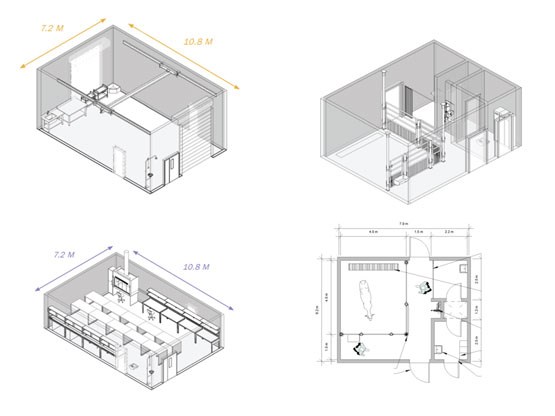
-
Example of a laboratory typology catalogue - Text version
Image 1: An angled architectural drawing of a rectangular laboratory.
This is an architectural diagram of an open space laboratory. The dimensions are 10.8 metres long and 7.2 metres wide. There is a roll-up entranceway at each end of the space on the width sides. Beside one roll-up entranceway is a standard doorway, opening to the exterior. On each length side there is a standard interior doorway, opening to other spaces.
At the ceiling of the lab there is a single beam, overhead bridge crane. In one corner is an eye wash station. At the other end of the laboratory space, there is an industrial sink, a work table is beside the sink and on the other side of the table are two rolling carts.
Image 2: An angled architectural drawing of a rectangular laboratory with workbenches.
This is an architectural diagram of a laboratory with various workstations. The dimensions are 10.8 metres long and 7.2 metres wide. There is one standard doorway on one of the width sides of the lab.
Along the walls of the space on the length, there are eight workstations four on each side. In the centre of the space are two rows of work tables, running nearly the entire length of the lab. There is space on the nearest end to allow for movement to each side of the lab.
In the farthest corner of the space, there is a workstation with a sealed fume hood and a tall storage unit beside it. In the closest corner of the space, near the doorway is an eyewash station.
Images 3 and 4: Two architectural drawings, one angled and one overhead of a laboratory to hold large animals.
There are two architectural drawings, one angled and one overhead, of a laboratory to hold large animals. The dimensions are 7.9 metres long and 6.2 metres wide. There are two extra wide doorways on each long side of the lab. On one long side there is also a standard doorway, opening into two small rooms along one short end of the lab.
The two rooms each have a sink and are connected to each other by standard doorways with a shower room between them. The small room opposite the doorway has a sliding curtain entrance that provides access to the rest of the lab.
In the main room, there is an animal pen. Two sides of the pen are the walls of the lab. The other two sides are steel corral pieces with a gate on each piece. There is walking space on the outside of the pen on the two corral sides.
Along one wall of the pen is a grate and drainage system for water and waste.
Significant progress was achieved in advancing the Repeatable Laboratory Design Framework, including refining the laboratory space typologies catalogue and addressing the technical content through dedicated workshops to address structural, mechanical, architectural and holistic building baseline performance targets. Advancements included the benchmarking of international world-class facilities, furthering the development of typologies for the science office accommodation approach, the completion of a toolkit for application in functional programming, addressing sustainability, the new government greening directives and guidelines for commissioning and building information management.
Consultations and engagements with partners and stakeholders occurred at earlier stages of the Repeatable Laboratory Design Framework development, with the next series of engagements to occur after the 66% completion milestone. Following the 66% milestone, next steps will be the completion of the Design Framework and the release of version 1 to seek further feedback from key experts within PSPC, the Treasury Board Secretariat, as well as with hub partners and other stakeholders.
The Science Office Accommodation approach is a section being developed within the Repeatable Laboratory Design Framework. It uses the Government of Canada Workplace Fit-Up Standards as a baseline for defining an appropriate allocation of office space within a science facility, and aligns with the concept of activity-based workplaces inherent in the GCworkplace Design Guide.
The intent of the Science Office Accommodation approach is to address the special technical and/or fit-up requirements to accommodate activities that support science functions and operations by enabling a flexible approach to planning and designing office space. Working with science hub representatives, Laboratories Canada and FRAMEWORK’s experts will continue to develop the Science Office Accommodation approach with lessons learned from the in-flight projects as they progress.
Custody/operating framework
Supporting the Laboratories Canada vision requires clearly defined custodial responsibilities and a definitive operating framework. A “custodian” is a department whose minister has administration of real property for that department. There are 17 policy requirements for a custodian to follow, as outlined in the Treasury Board Secretariat Policy on Management of Real Property.
While custody outlines ownership and stewardship accountabilities, service management and delivery refers to how buildings and grounds are managed. This is key in the successful running of the new facilities now and into the future.
Over the 2020–2021 period, the Laboratories Canada Office has researched and assessed various custodial arrangements and proposed an operating framework that takes into consideration partners’ situations.
The first finding highlighted the need to blend three distinct roles for each science facility. Those roles are the Science Program Authority, responsible for science program business requirements; the Real Property Custodian, who holds administrative authority for land and buildings; and the Operations Service Provider, who is responsible for the delivery of all operational services to required service levels.
One Science Site – Three Roles
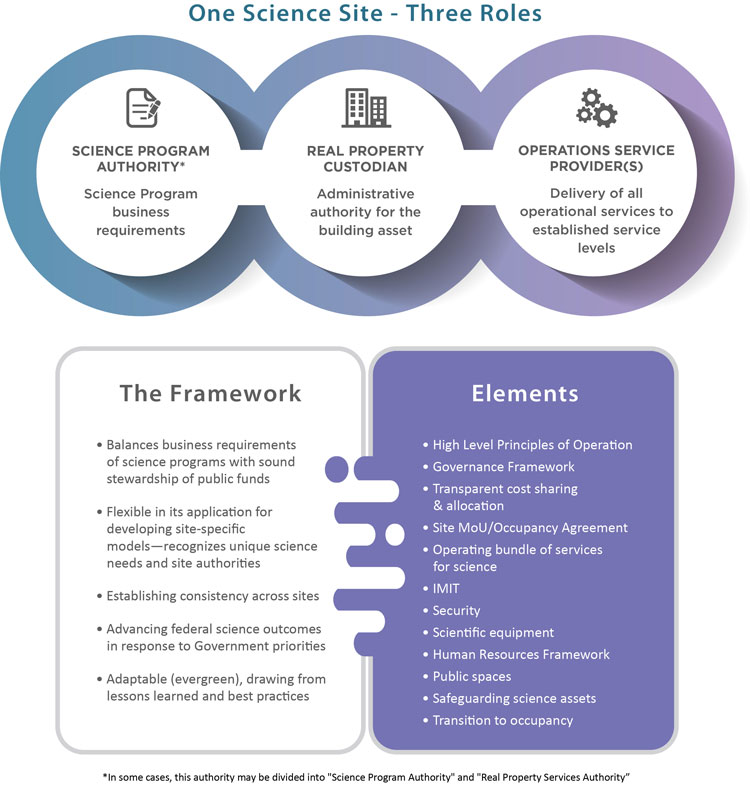
-
One Science Site – Three Roles - Text version
The title of the image is “One Science Site – Three Roles.” Along the top of the image are three connected circles representing the three roles of each site.
The first role is Science Program Authority that deals with the science program business requirements. It is noted that, in some cases, this authority may be divided into “Science Program Authority” and “Real Property Services Authority.”
The second role is that of Real Property Custodian, which addresses administrative authority for the building asset.
The third role is that of Operations Services Provider or Providers, which is responsible for delivery of all operational services to established service levels.
Below the circles are two boxes meshed together indicating that the two lists are interconnected.
The first box identifies the framework and the second box identifies elements.
Within the framework box are the following points:
- Balances business requirements of science programs with sound stewardship of public funds
- Flexible in its application for developing site-specific models – recognizes unique science needs and site authorities
- Establishing consistency across sites
- Advancing federal science outcomes in response to Government priorities
- Adaptable or evergreen, drawing from lessons learned a best practices
Within the elements box are the following points:
- High-level principles of operation
- Governance framework
- Transparent cost sharing and allocation
- Site Memo of Understanding or occupancy agreement
- Operating bundle of services for science
- IMIT
- Security
- Scientific Equipment
- Human Resource Framework
- Public Spaces
- Safeguarding science assets
- Transition to occupancy
Laboratories Canada then engaged science hubs with active projects on discussions to establish clear custody and operating framework of the new science facilities that will meet the needs of those involved.
To support these discussions, Laboratories Canada developed a custody model analysis framework that applied guiding principles, requirements and evaluation criteria to explore different model options.
Taking into account the steps completed in 2020, the process to determine who would be the custodian of each facility began in January 2021 with a third-party review of organizational self-assessments and supporting evidence. That was followed by additional engagement with the science hubs to review the data provided and recommendations.
Information management/information technology
Modern IM/IT infrastructure is a critical enabler for science. Laboratories Canada’s IM/IT strategy strives to provide new laboratories with innovative technologies and world-class Government of Canada-wide digital science infrastructure. Laboratories Canada and Shared Services Canada are working together with the science community and science hubs to develop and deliver IM/IT for Phase 1 construction projects, in addition to leading the modernization of the IM/IT science services.
IT Overview Triangle 2022
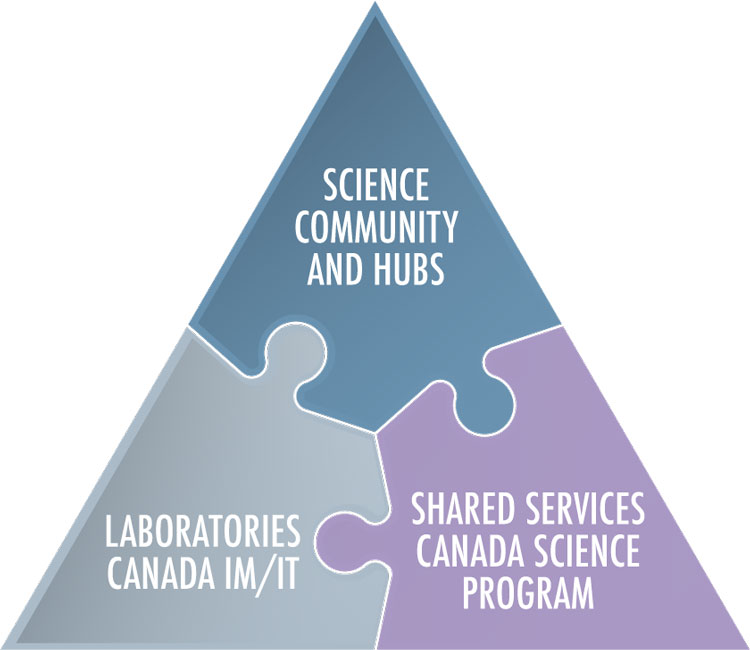
-
IT Overview Triangle 2022 - Text version
Puzzle of a triangle showing the connectedness of science community and hubs, Laboratories Canada IM/IT and, Shared Services Canada Science Program.
IM/IT for Phase 1 Construction Projects
Laboratories Canada and Shared Services Canada are collaborating with the hubs to capture requirements and deliver solutions that will meet present and future science requirements. Working groups were established to help define the IM/IT capabilities required for each science hub, including data and storage, collaboration, networking, and cloud requirements. This information will further inform infrastructure design and special purposing of space. Additionally, the information defines elements such as physical square footage required for equipment, ventilation and cooling, corporate office-type wiring closets and cabling, etc., as per real property standards.
Modernization of the IM/IT Science Services
As part of its long-term, whole-of-government strategy for modern, agile, and secure IM/IT infrastructure, Laboratories Canada and Shared Services Canada are developing solutions and services to support the Phase 1 science hubs with the help of the larger research and IT community. By default, Shared Services Canada, will add these services to the Shared Services Canada service catalogue to support all federal science. Through pathfinder projects, these services have been developed as pilots within the community and are meant to address major digital science challenges or limitations. These challenges summarize the needs narrative from various studies from partners, collaborators and the community.
Five Sections of the digital science and technology community
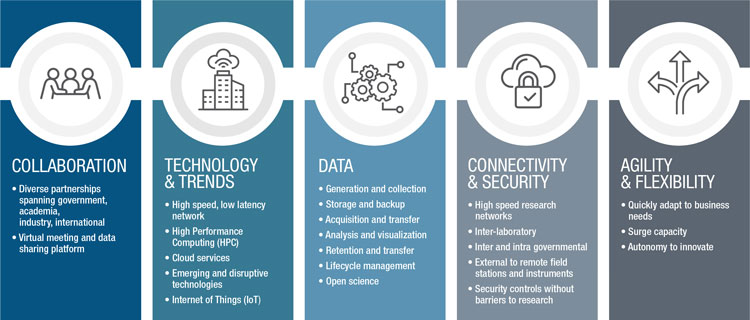
-
Five Sections of the digital science and technology community - Text version
There are five columns, with each representing the types of support provided by the digital science and technology community in the development of science laboratory facilities.
The first column on the left is collaboration and includes two points. One is diverse partnerships spanning government, academia, industry and international. The second is virtual meeting and data sharing platform.
The second column, moving to the right, is technology and trends with five points: high speed, low latency network, high-performance computing, cloud services, emerging and disruptive technologies and lastly, Internet of things.
The next column is data, which includes the following points: generation and collection, storage and backup, acquisition and transfer, analysis and visualization, retention and transfer, lifecycle management and, open science.
The fourth column is connectivity and security with the following points: high-speed research networks, inter-laboratory, inter and intra-governmental, external to remote field stations and instruments and lastly, security controls without barriers to research.
The final column on the right is agility and flexibility. This includes the points of: quickly adapt to business needs, surge capacity and, autonomy to innovate.
Community Engagement
IM/IT Working Groups
Laboratories Canada engages the IM/IT community through various committees. There are associated IM/IT working groups within every laboratory construction project, with members from both the research and IT sectors of each participating department. The working groups are established to support all phases of the lab construction project. This support ranges from gathering requirements and active participation to the design of all hub-specific IM/IT solutions, while considering the evolving needs of the science community as a whole.
Digital Science and Technology Community
The Digital Science and Technology Community was established, in collaboration with Shared Services Canada, as a sounding board to engage the community with the modernization of digital science infrastructure and services for the federal science community. The community acts as a partnership of federal organizations working together towards scientific advancement in relation to research and development of emerging digital science and technology methods, tools, applications and others. One role of the Digital Science and Technology Community is to help with the identification and prioritization of Laboratories Canada and Shared Services Canada’s activities, such as the development of new services, procurement of technology, and real property standards for laboratory fit ups. The Digital Science and Technology Community also facilitates connections, collaborations and communications within the Government of Canada and with the private sector, academia and others to ensure optimal synergies in future services’ development and investment.
Experimentation and Innovation
Beyond the operational engagement, an experimentation and innovation program was established to promote the research and development of digital science IT pilots in the scientific community. These pilot projects aid Laboratories Canada and Shared Services Canada with the identification of potential solutions or services to modernize the digital science landscape.
Shared Services Canada Science Program as a Key Partner
Shared Services Canada committed to establishing the science program as an organizational unit under the Chief Technology Branch to lay the foundation for the ongoing support and development of IT services for science. Laboratories Canada was a catalyst for establishing such a program through, for instance, financial support in start-up years. This demonstrates a commitment to delivering the services and tools that the whole of federal scientific community needs to perform leading-edge science.
Collaborative IM/IT Support
Laboratories Canada is collaborating with partners at Shared Services Canada, developing an integrated delivery model to efficiently support the IM/IT needs of the federal science community, not only in the new facilities, but throughout the entire science ecosystem.
The Laboratories Canada Office, responsible for developing an enterprise-wide approach for the implementation of information management, technology and supporting innovation across all Laboratories Canada science facilities, provides consistency and efficiency to support science business requirements, including collaboration and the adoption of new technologies.
The Shared Services Canada Science Program, collaborating in the planning and implementation of activities related to Phase 1, identifies requirements and service delivery options to meet the business needs of science and those of the science hubs. Together, the Laboratories Canada Office and the Science Program are working as an integrated team to successfully meet the needs of the federal science community.
The benefits of this collaboration were demonstrated recently. In support of the pandemic response, Laboratories Canada, working with Shared Services Canada, played a key role in delivering a secure science network in less than three months. The leap in network development created the opportunity for science-related work to be achieved remotely, with researchers knowing their work was secure.
Committed to this collaborative path, Laboratories Canada will continue to work with Shared Services Canada to apply lessons learned to meet secure networking requirements of the federal science community.
Scientific equipment
Access to modern scientific equipment is essential for federal scientists to support their department/agency mandates to effectively collaborate with partners, and perform at the highest levels of excellence. Laboratories Canada is developing a series of strategic objectives to provide federal scientists access to lifecycle management and modern scientific equipment. These strategies will enhance equipment-sharing and collaboration, optimize investments in scientific equipment, establish a federal scientific equipment inventory system, and support the laboratory design and construction processes for a successful transition into new facilities.
The following are some of the key activities completed in support of the implementation of the scientific equipment strategy:
Scientific Equipment and Science Platform Sharing:
A federal community-wide workshop on sharing and collaboration resulted in the launch of four pilot projects to develop best practices and models for collaboration, cost recovery and operating frameworks for scientific equipment.
Canada Foundation for Innovation Research Facilities Navigator:
Continued collaborative efforts with the Foundation’s Research Facilities Navigator to enhance extramural collaborations across publicly funded laboratories.
Scientific Equipment Inventorying:
Developed inventorying, cataloguing and costing process for federal scientific equipment to ensure equipment is adequately planned and designed for the new facilities.
Strategic objectives
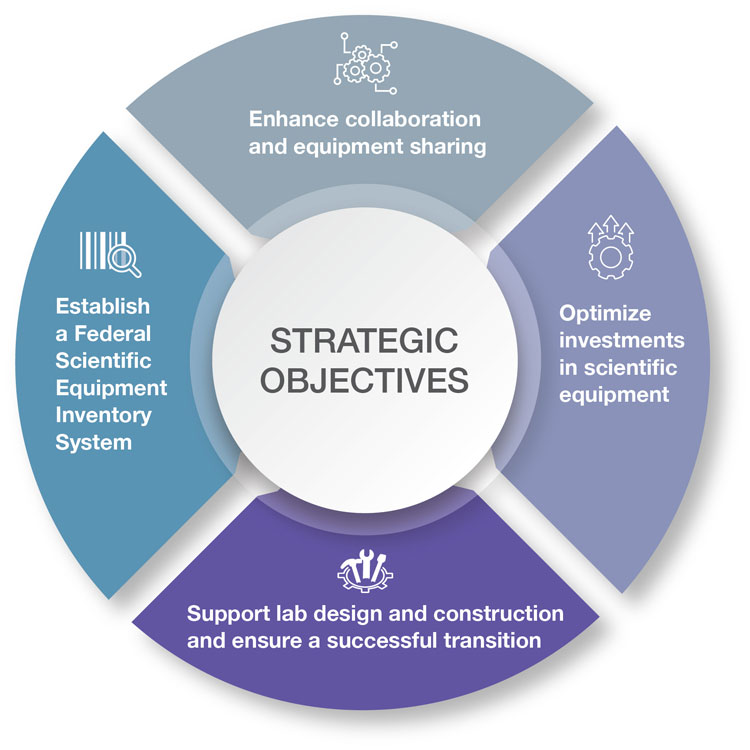
-
Strategic objectives - Text version
There is a circle made of four equal segments, surrounding the inner circle that represents the strategic objectives of the equipment strategy. The first segment objective is to establish a federal scientific equipment inventory system. The objective of the second segment indicates the objective to enhance collaboration and equipment sharing. The third segment is to optimize investments in scientific equipment. The final segment has the objective to support lab design and construction and ensure a successful transition.
Security
Woven throughout the guiding principles and the delivery of these new facilities is the supporting security. The overall objective of security in the Laboratories Canada facilities is to create safe and secure environments that foster scientific innovation, accessibility and collaboration by ensuring the protection of national security and intellectual property.
Modern and holistic security measures are being integrated into the requirements of future facilities to protect people, assets and information. Long-term solutions have been implemented to ensure efficiency and cost-effectiveness in the ever-changing threat environment of scientific research.
Laboratories Canada’s guiding principles include collaboration and resource-sharing, and security aims to enable this safely. Environments and processes are in place to facilitate collaboration with industry, academia, the Canadian public and other foreign entities. Such processes enable positive and cooperative relationships while minimizing the risk of insider threat and espionage.
Standardized and robust security programs are being developed for all Laboratories Canada science and research facilities. These programs adhered to the pre-existing Government of Canada policies and standards while also responding to the federal science partners’ unique and wide-ranging security needs.
Partnerships and stakeholder relations
Supporting collaboration is a key component of the Laboratories Canada strategy, and it is also woven throughout the entire process of delivering all projects. Therefore, identifying and fostering collaborative relationships with partners and stakeholders is fundamental to the strategy’s success.
Partnerships
The approach to partnerships is threefold: communication, collaboration, and adaptability. This was particularly true in 2020–2021, as the pandemic required Laboratories Canada to be sensitive to hubs’ needs as regulatory departments had to prioritize pandemic response.
There are presently three key groups of partners in the Laboratories Canada strategy who interact on an almost daily basis:
- The Hub Management Offices, which are coordinating the work on the ground and in between departments to achieve collaborative science.
- The Laboratories Canada Office, which support the hubs in terms of project delivery, information technology or change management, to name a few. Regular touch points take place between each team to ensure maximum synergy, especially as the pandemic created additional pressure for some federal departments and agencies.
- The senior leaders and Governance Committees, who provide oversight and direction for Laboratories Canada.
Clear communication
We believe in two-way communication. We articulate our objectives, listen, check for understanding and are responsive.
Collaboration
We believe in the power of working together. We work closely with various teams to understand interests and challenges and together define a common path forward.
Agile, adaptable and open to change
We learn from each other and our partners—and share this knowledge.
In 2020–2021, there were key developments in strengthening relations with the science community, with infrastructure and construction stakeholders and with Indigenous groups. Most notably, concrete actions were taken to increase Indigenous peoples’ perspectives and participation throughout Laboratories Canada projects, in line with the Government of Canada efforts towards advancing reconciliation and renewing the relationship with Indigenous peoples. These lay the groundwork for future increased Indigenous participation and the braiding of Indigenous traditional knowledge into federal science.
Stakeholder Relations
Indigenous STEM Clusters
Seeking to uphold the vision to braid Indigenous knowledge in its activities and projects, PSPC Deputy Minister Bill Matthews and Assistant Deputy Minister Rob Wright signed a memorandum of understanding with the federal interdepartmental Indigenous STEM Cluster hosted by Agriculture and Agri-Food Canada in Spring 2021. Over the next three years, the I-STEM memorandum of understanding will allow PSPC to collaborate with a dozen federal Cluster members to advance Indigenous leadership and participation in STEM (science, technology, engineering, and mathematics) disciplines and research. As a member of the I-STEM Cluster, PSPC will also leverage synergies with other federal and external partners, jointly delivering key initiatives and policy products to advance Indigenous STEM at both national and international levels.
The I-STEM Cluster works to inform and enhance policies to advance Indigenous aspirations and innovation in agriculture and natural resource stewardship. The Cluster promotes a more culturally inclusive environment for all, including Indigenous and non-Indigenous researchers and scientists. The I-STEM Cluster is comprised of natural resource science-based departments, including Agriculture and Agri-Food Canada, the Department of Fisheries and Oceans, Environment and Climate Change Canada and Natural Resources Canada. Its membership will continue to expand as the initiative gains momentum.
I-STEM Advisory Circle
One of the key commitments under the I-STEM memorandum of understanding is the creation of an I-STEM Advisory Circle. A group of Indigenous appointees will offer advice and guidance to the I-STEM Cluster members. Guided by a series of principles aimed at fostering a reciprocal relationship, the Wisdom Panel composition reflects the diversity of First Nations, Inuit, and Métis Nation Peoples and Canada’s geographic regions. PSPC has been identified as the lead liaison to coordinate the new I-STEM Advisory Circle Secretariat.
PSPC worked with Agriculture and Agri-Food Canada, other key Cluster members and an Indigenous consultant on developing the I-STEM Advisory Circle concept, which was endorsed by the I-STEM Cluster Assistant Deputy Minister Governance Committee members in March 2021.
The I-STEM Advisory Circle consists of five to eight Indigenous science experts from among the three groups: First Nations, Inuit, and Métis Nation. The Advisory Circle and its members intend to:
- Bring national-level advice to federal science-based departments and agencies, complementing Western science perspectives;
- Share perspectives on how to best advance the application of multiple knowledge systems within federal science;
- Provide guidance, including best practices and protocols, on how to braid Indigenous and Western science; and
- Advise on extending facilities/laboratories in Indigenous communities and territories by participating in knowledge creation.
The establishment of the I-STEM Advisory Circle stemmed from a co-development approach within a reciprocal, knowledge-sharing environment to:
- Create a space for panel members to share their experience and expertise from both Western STEM and Indigenous perspectives;
- Ensure the inclusion of Indigenous worldviews, knowledge systems, teachings, values, and oral traditions; and
- Enhance the meaningful inclusion of Indigenous Peoples, communities and organizations in STEM knowledge creation.
2020 Canadian Science Policy Centre Conference
The Canadian Science Policy Centre’s annual conference took place in November 2020. As a partner for the third consecutive year, the Laboratories Canada Office led the coordination of a discussion panel focused on including Indigenous perspectives and the need for an integrated approach towards science delivery, and moderated its discussion.
The panel was comprised of diverse experts that shared their experiences and insights from both Western science and Indigenous knowledge systems.
Laboratories Canada Office Discussion Panel
Natalka Cmoc
Director General of Science and Policy, Science and Parliamentary Infrastructure Branch, Public Services and Procurement Canada.
Dr. Fred Wrona
Environment and Parks Chief Scientist of Alberta.
Dr. Jacqueline Ottmann
Misiway komiguk paypomwayotung, Anishinaabe (Saulteaux), Vice-Provost Indigenous Engagement, Professor, University of Saskatchewan.
David Fortin
Member of the Métis Nation of Ontario, Associate Professor and Director of School of Architecture, Laurentian University.
Melody Lepine
Treaty 8 Mikisew-Cree First Nation, Director of Mikisew-Cree First Nation Government and industry relations.
Dr. Keith Chaul
Former Vice-President, Indigenous with the University of the Arctic.
The panellists focused on approaches to best advance the application of multiple knowledge systems in the development and delivery of federal science, and knowledge generation in Indigenous communities with an emphasis on facility/laboratory design. The discussion also touched on how facilities and laboratories extend into the traditional territory of Indigenous communities that participate in knowledge creation.
These discussions demonstrate that the advancement of Canada’s science delivery requires a more comprehensive, integrated, interdisciplinary and transdisciplinary approach that recognizes, from day one, the benefits of braiding multiple knowledge systems together.
Relationship building with Indigenous communities and learning from Indigenous knowledge holders are integral to this. To foster deeper and more effective ties, communication, and discussion, it is imperative to have the appropriate physical spaces to facilitate knowledge co-production. The braiding of Western science and Indigenous science will lead to a stronger knowledge base and improve Canadian policy formulation.
Laboratories Canada aims to anticipate the needs of science in the future, and to support such innovative approaches to federal science program design and delivery.
2021 International Conference on Research Infrastructures
The International Conference on Research Infrastructures brings together policy experts, facility managers, leading researchers, and various other stakeholders to discuss challenges and emerging trends for research infrastructures around the world.
The 2021 conference was hosted by the Canada Foundation for Innovation with funding from the European Union. For the first time, the Laboratories Canada Office took part in this conference as a partner along with the Canadian Institutes of Health Research, the Natural Sciences and Engineering Research Council of Canada, the Social Sciences and Humanities Research Council and the National Research Council of Canada. This conference allowed Laboratories Canada participants to learn from partners and like-minded organizations to better support the development of scientific facilities.
Evolution of governance
Laboratories Canada is a long-term strategy involving a number of partners and stakeholders. To ensure cohesion, coherence, and accountability, a strong and nimble governance model is required to support evidence-based decisions.
To this end, a planned governance review was led by PSPC’s Chief Audit Executive in 2019 and identified opportunities to enhance and simplify the governance of the strategy.
Laboratories Canada and the science hubs responded to the review by embarking on a governance review exercise. This included thorough consultations during summer 2020 at both the enterprise and science hub levels, and included adjusting governance to streamline enterprise-level decision-making; furthering the integration of the hubs’ science expertise within the end-to-end lifecycle of both their projects and the overarching program; and finally, clarifying the way items will move up through governance. The important role of Shared Services Canada in the development of project and program IM/IT requirements was also further defined.
This work resulted in changes to the Deputy Minister Science Committee, which was renamed the Deputy Minister Community of Science and Technology and reoriented to focus on cross-government science policy, removing oversight of Laboratories Canada. This laid the foundation for the Laboratories Canada partners to review the Deputy-level governance of the strategy, and begin work on forming a new Deputy Minister governance body to guide the implementation of the strategy through the shift from planning into delivery of Phase 1 projects.
Indicative of its commitment to innovative approaches and continuous improvement, Laboratories Canada was selected by the Treasury Board Secretariat to participate in a government-wide pilot project to identify how government can become more nimble and provide greater oversight and accountability for Canadians. For Laboratories Canada, this pilot focuses on the continual analysis of its governance processes and outputs in order to make adjustments in real time. This strengthened the bond with our government partners and confirmed Laboratories Canada as a strategy willing and capable of taking on the challenges of the future.
Managing transformation
The delivery of a program as complex, multifaceted and transformational as Laboratories Canada requires a rigorous and integrated risk management process. Laboratories Canada has developed tools and operationalized a process that supports a better integrated and more collaborative approach to risk management: the Laboratories Canada Risk Management Framework.
The framework aims to provide a systematic approach to identifying and managing risks, opportunities and issues across all levels of the Laboratories Canada program. The framework aligns with PSPC project management practices while expanding in areas specific to the nature and complexity of the Laboratories Canada strategy. Laboratories Canada launched the risk management process in 2020 and has been working closely with partners to operationalize the Risk Management Framework for Phase 1 science hubs. The framework is reviewed annually to incorporate feedback from colleagues and partners across the enterprise and continually improve the risk management process.
Through the operationalization of the Risk Management Framework, risks are kept up to date on a regular cadence. Integrated risk sessions allow teams to align risks across levels, collaborate on response strategies and regularly perform integrated risk analysis.
A key to risk mitigation at Laboratories Canada is collaboration with partners and stakeholders. Effective horizontal governance is a key enabler for the program strategy and is critical to ensuring informed, collaborative direction and decisions to advance the program and projects. A reporting strategy on risks and issues at governance bodies continues to be developed to support risk and issues-based discussions and decision-making.
Laboratories Canada’s Risk Management Framework is enhanced through the involvement of the Chief Audit Executive community. Chief Audit Executives from implicated departments and agencies are actively engaged with Laboratories Canada to provide assurance early in program and project implementation. This ongoing, real-time focus on providing constructive guidance to support the science hubs, PSPC, as an implementer, and of the whole community as partners whose effective collaboration will determine how well we collectively realize the foundational science goals brings an uncommon and high-value perspective to all involved.

